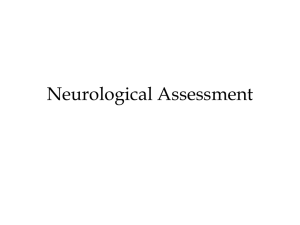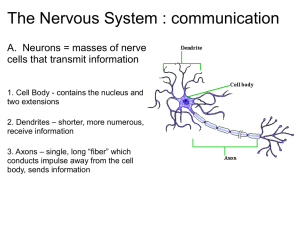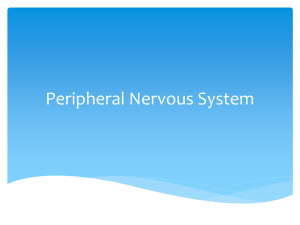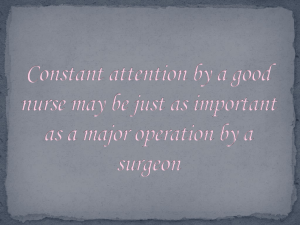Nervous System
advertisement
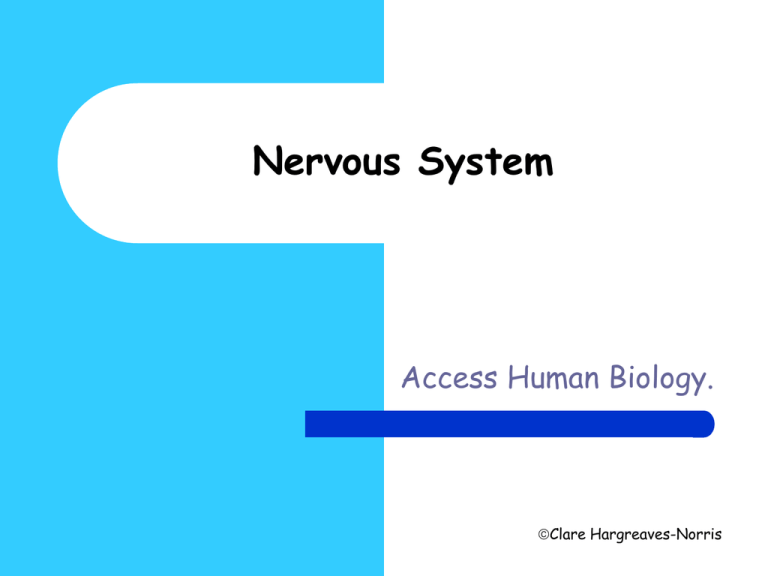
Nervous System Access Human Biology. Clare Hargreaves-Norris Introduction The nervous system is the main communication system for the body and is responsible for receiving and interpreting information between the various parts of the body and the brain. The three main sections of the nervous system are called: The central nervous system (CNS). The peripheral nervous system (PNS). The autonomic nervous system (ANS). Clare Hargreaves-Norris Central Nervous System Clare Hargreaves-Norris Structures of the central nervous system The central nervous system comprises of the: Brain Spinal cord Cerebro-spinal fluid Meninges Clare Hargreaves-Norris Spinal cord The spinal cord is a continuation of the medulla oblongata and extends downwards through the vertebral column, finishing on a level with the lumbar vertebrae. It is protected by the vertebral column, 3 meninges and the cerebro-spinal fluid. The functions of the spinal cord are: It conveys sensory impulses from one area of the spine to another and from the skin and muscles of the trunk and limbs to the brain. It allows and co-ordinates spinal reflex actions, which are a rapid response to a stimulus without any conscious thought of the brain. This action protects the body from danger before any harm is caused. Clare Hargreaves-Norris The brain The brain is the most important part of the nervous system. It is the main communication centre. The brain is protected by: -The cranial bones of the skull. -The cranial meninges (Three membranes that cushion the brain and contain blood vessels). -The subarachnoid space (Contains the cerebrospinal fluid, provides further cushioning and supplies nutrients. Clare Hargreaves-Norris Responsibilities of the brain The brain is responsible for: Storing messages that it receives from all different parts of the body via the sensory nerve endings. Transmitting messages via the motor nerves to all different parts of the body to stimulate the required response. Co-ordinating the body’s movements. Controlling feeding. Controlling sleeping patterns, Controlling temperature regulation. Controlling the salt/water balance of the body. Storing information in the memory. Emotional and intellectual processes. Clare Hargreaves-Norris Areas of the brain - cerebrum The cerebrum is the largest region of the brain. It is spilt into two hemispheres It has a surface called grey matter. It enables vision, touch, taste, smell and hearing. It also controls muscular movements, emotions, thought processes and personality traits. Clare Hargreaves-Norris Areas of the brain - diencephalo The diencephalon comprises of the thalamus & hypothalamus and makes up part of the forebrain. The thalamus relays sensory impulses to the cerebrum. The hypothalamus controls the autonomic nervous systems. The hypothalamus regulates: - heart rate. - body temperature. - salt/water content, - appetite. - sleeping patterns. Clare Hargreaves-Norris Areas of the brain - cerebellum The cerebellum is located in the posterior aspect of the brain. It maintains muscle tone, posture and controls motor skills. Clare Hargreaves-Norris Areas of the brain – brain stem The Pons and Medulla oblongata are known as the brain stem. This is a continuation of the spinal cord. It controls what you have no conscious control over such as: - blood pressure - body temperature. Clare Hargreaves-Norris Nerves Neurones, more commonly known as nerves, are made from a collection of nerve fibres and all emerge from the CNS. There are 3 types of nerves: Motor (efferent) nerves - conveys impulses from the brain, through the spinal cord to the muscles, glands and smooth muscular tissue. Sensory (afferent) nerves - conveys impulses from the sensory nerve endings situated in various organs, skin etc. to the brain & spinal cord. Mixed nerves - are a combination of motor and sensory nerve endings. Clare Hargreaves-Norris Structure of a neurone Each neurone has: A cell body – containing the nucleus, mitochondria & other organelles. Dendrites – several short projections that receive information from other cells and transmit the message to the cell body. Axon – one long projection that conducts messages away from the cell body. Axons have a myelin sheath, which insulates them to prevent against loss of electrical impulses and therefore increase the speed at which the impulse is conducted. Clare Hargreaves-Norris Diagram of a neurone Clare Hargreaves-Norris Transmission of nerve impulses Messages pass along the nerve fibres as electrical impulses, which are the result of changes that are present inside and outside the nerve membrane. When an impulse reaches the end of the nerve fibre, a chemical is released called a neurotransmitter substance. The chemical passes across a tiny gap called a synapse and generates an electrical impulse in the next neurone. When the neurone reaches a muscle fibre, it is referred to as a motor end plate. A similar reaction occurs at the motor end plate, however a chemical transmitter substance is released from the synaptic vesicle this time. In simple terms, messages cross the synapse by electrical impulses. Clare Hargreaves-Norris Synapse at nerve muscle junction known as motor end plate Clare Hargreaves-Norris Passage of a nerve impulse A sensory receptor in the skin picks up a message from the outside world, for example heat, cold, touch, pain or pressure. The message, in the form of an electrical impulse, conveys from the dendrites to the cell body and then along the axon. The electrical impulse travels along the axon until it reaches the next neuron, whereby a neurotransmitter substance is released to allow the impulse to pass the small gap called a synapse. Messages cross the synapse by an electrical impulse. The impulse crosses the gap and onto the dendrite of the adjacent sensory neuron, where it continues on its journey until it eventually reaches the brain. The brain perceives the sensation and sends a message back via motor nerves; until the message reaches a neuro-muscular junction known as a motor end plate. The synaptic vesicle releases a chemical transmitter substance, allowing the impulse to reach the muscle fibres. The impulse tells the muscle fibres to contract or relax, thereby bringing about a response. Clare Hargreaves-Norris Reflex action Sometimes the impulse does not pass to the brain. It is dealt with by the spinal cord. This is an involuntary response to a stimulus whereby a very fast response is required. This is referred to as a reflex action. The message will be sent on to the brain after the event to make you aware of what has occurred. Clare Hargreaves-Norris Can you think of examples of reflex actions? Someone blowing in your eye. Burning your hand on something hot. Patella knee jerk test. Pricking your hand on a needle. Choking. Vomiting. Clare Hargreaves-Norris Motor point The motor point is the position where the motor nerve inserts into the muscle belly at its most superficial point. Therefore, it is the most accessible way to stimulate the motor nerve in order to produce a muscle contraction. Clare Hargreaves-Norris Peripheral Nervous System Clare Hargreaves-Norris Peripheral nervous system The peripheral nervous system is composed of the parts of the nervous system outside of the central nervous system and consists of: 31 pairs of spinal nerves 12 pairs of cranial nerves The autonomic part of the nervous system Clare Hargreaves-Norris The cranial nerves There are 12 pairs of cranial nerves that originate from the brain. Most are confined to the head and neck, but the tenth nerve has branches in the trunk. Some of these nerves are mixed, while others are either motor or sensory. Clare Hargreaves-Norris The spinal nerves There are 31 pairs of spinal nerves, which emerge from in-between the vertebrae of the spinal column. All spinal nerves are mixed nerves and they have two points of attachment to the spinal cord and these are referred to as roots. The dorsal root carries sensory axons whose impulses are passing inward. The ventral root carries motor axons whose impulses are passing outwards. The names of the 31 pairs of spinal nerves depend on the region of the spine they emerge from: Clare Hargreaves-Norris Spinal Nerves (31 Pairs). Eight pairs of cervical nerves Twelve pairs of thoracic nerves Five pairs of lumbar nerves Five pairs of sacral nerves One pair of coccygeal nerves Clare Hargreaves-Norris Nerve plexuses Each spinal nerve divides into branches, with the posterior branches supplying the muscles and skin of the back. The majority of the anterior branches form plexuses (networks) on either side of the body: Cervical plexuses cover the neck, head and upper shoulder region. Brachial plexuses supply the skin and muscles of the arms, shoulders and upper chest. Lumbar plexuses supply the abdomen and part of the leg; the femoral nerves are the largest nerves of the lumbar plexuses, and these supply the front of the thigh. Sacral plexuses supply the buttocks and some of the leg; the sciatic nerves from these plexuses are the largest nerves in the body, and supply the muscles of the legs and feet. Clare Hargreaves-Norris Autonomic Nervous System Clare Hargreaves-Norris The autonomic nervous system This is the involuntary part of the peripheral nervous system. It controls the body activities that are not under conscious control. There are two parts to this system, which work antagonistically, meaning that they produce opposite effects. The parasympathetic system is concerned with energy conversion. The sympathetic system is concerned with increasing the body’s use of energy. Together they maintain homeostasis, as one system counteracts the effects of the other. Clare Hargreaves-Norris Sympathetic system The sympathetic system is mainly active at times of stress. It is concerned with increasing the body’s use of energy. It is comprised of interlinked nerves called plexuses. For example the system raises the heart rate, increases the breathing rate, and slows down the digestive system to prepare the body for fight or flight. Clare Hargreaves-Norris Parasympathetic system The parasympathetic system is mainly active at times of peace. It is concerned with energy conservation. For example the heart rate is normalised, the digestive functions are maintained and the blood supply to the muscles is reduced. Clare Hargreaves-Norris At times of stress The sympathetic impulses become stronger. The heart beats faster, blood vessels dilate, hairs stand on end. The sweat glands produce more sweat and blood pressure rises due to the constriction of small arterioles in the skin. Adrenaline is produced and the metabolic rate is increased. When the stressful situation passes the parasympathetic nerves take over and help the function of the organs return to normal and prepare the body for rest. Clare Hargreaves-Norris

